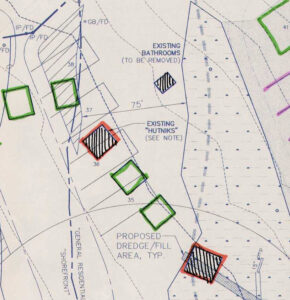Freedom—August 26, 2024—At least two of the six “hutnick” structures that Wabanaki Campground wants to expand and sell as part of a proposed 77-site “membership campground” were supposed to be removed years ago as part of a legal settlement with DES, according to newly-obtained state documents.
A plan to expand and make permanent the bare bones, tent-like “hutnick” structures is pending with Freedom’s Planning Board as part of a commercial site plan application submitted in March by Wabanaki Campground Conversion LLC and its owner/manager, Mark Salvati.
In 2001, DES issued a cease-and-desist order that closed the 11-acre Ossipee Lake business after it learned it was operating an 80-site campground without a permit or an approved septic system.
As part of their settlement with the state, then-owners Elmer and Janice Franson submitted a subdivision plan that included constructing two septic systems, designated as System 1 and System 2, to serve 50 campsites.
The subdivision plan stated that two of the “hutnicks,” noted as 3 and 6, would be removed as part of constructing Septic System 1. The other four “hutnicks” were to be removed at a future date and turned into campsites 35, 37 and 38.
Septic Systems 1 and 2 were put into service, but all six “hutnicks” remained and are the objects of the recent expansion application.
In response to an email from Ossipee Lake Alliance, Salvati, who is related to the Fransons, said his recollection was that the “hutnicks” were to be removed “when feasible, but it was never feasible.”
Told that the subdivision document does not state that removing “hutnicks” 3 and 6 was optional, Salvati said the structures were “being used by family members, so it just never happened.”
Ongoing Document Search
The requirement to remove the hutnicks was discovered as part of a search of documents that began in April after key information about the property could not initially be located in town files.
Among the documents found to date is a 1970 plan, and 1977 amendment, in which the town approved the property as a 16-lot residential subdivision for single-family homes with individual septic systems and community water.

Cross-hatched “hutnicks” were to be removed during the 2001 construction of septic systems to settle legal issues with the state.
The documents state that camping was to be prohibited. It is not known when the Fransons started renting campsites for trailers, or whether the couple obtained town approval to do so.
As part of the 2001 subdivision plan that settled the couple’s legal issues with DES, a third septic system, System 3, was approved but never built. The business has long claimed to have 67 campsites, but only 50 sites were approved to connect to Septic Systems 1 and 2.
Asked last week about how the campground provided sanitary services to the other 17 campsites, Salvati said they were “transient sites,” and since there was a public bathroom, no sanitary services were needed.
After “they became seasonal,” he added, he applied for approval for the third system, which was installed this year in preparation for co-op style ownership by individuals.
“I cannot say that no trailer other than the 50 were ever connected to Systems 1 and 2, but not very often, if any,” he told the Alliance.
Board to Meet in September
The new findings may affect how the Planning Board proceeds when it meets to discuss the campground’s expansion application on September 19.
At the board’s July 18 meeting, several Planning Board members said they were concerned about reviewing the “hutnik” expansions in isolation from the rest of the property.
The owner’s request to waive the requirement to provide a stormwater management plan was denied by the board, but it prompted a discussion in which board members Anne Cunningham and Brian Taylor recommended that the required stormwater plan include the entire property, not just the “hutnicks.”
Taylor said he saw “serious erosion” and “sand going into the lake” during an April site walk of the property. The state of the property’s system of drainage ditches, catch basins and culverts, built years ago to capture and carry stormwater into the lake, is not publicly known.
Taylor also said he was concerned that because of the way the applicant’s subdivision plan is set up, a signature approving the “hutnick” expansions would be tantamount to approving the entire subdivision document, the accuracy of which the board has not determined.
The question of signing-off on the full document remained unresolved at the end of the meeting, but the stormwater management plan question was resolved by a vote to limit its scope to the impact of the “hutnick” expansions.

glad to see some people are examining this issue more thoroughly …..